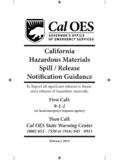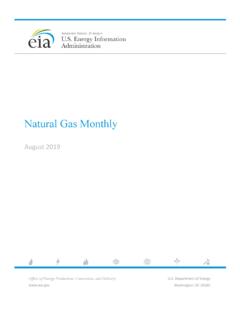Transcription of RR630 - Area classification for secondary releases from ...
1 Health and Safety Executive Area classification for secondary releases from low pressure natural gas systems Prepared by the Health and Safety Laboratory for the Health and Safety Executive 2008 RR630 Research Report Health and Safety Executive Area classification for secondary releases from low pressure natural gas systems Dr M J Ivings, Mr S Clarke, Dr S E Gant, Mr B Fletcher, Dr A Heather, Mr D J Pocock, Dr D K Pritchard, Mr R Santon, Mr C J Saunders Health and Safety Laboratory Harpur Hill Buxton Derbyshire SK17 9JN The ATEX Workplace Directive (1999/92/EC) has been implemented in the UK as the Dangerous Substances and Explosive Atmospheres Regulations (DSEAR) 2002 and by similar regulations in other EU member states.
2 These regulations require area classification to be carried out where there may be a risk of explosion due to the presence of flammable substances in the form of gases, vapours, mist or dust. Any equipment used to ensure safe operation in a classified hazardous area falls within the scope of the regulations. The regulations have major implications for all non-domestic natural gas installations. Whilst area classification has been applied to high-pressure natural gas installations in the past, it is now necessary to consider it for all pressures including distribution pressure.
3 Hazardous areas are classified into zones based on the frequency of the occurrence and the duration of an explosive gas atmosphere. In the case of a secondary release , the relevant zone is zone 2 and is defined as a place where an explosive atmosphere is not likely to occur in normal operation but, if it does occur, will persist for a short period only. In areas where the ventilation can be regarded as high relative to the leak size, BS EN 60079:10 recommends that the area classification is zone 2 but of negligible extent (NE) such that no action is thus required to control sources of ignition within it.
4 This report and the work it describes were funded by the Health and Safety Executive (HSE). Its contents, including any opinions and/or conclusions expressed, are those of the authors alone and do not necessarily reflect HSE policy. HSE Books Crown copyright 2008 First published 2008 All rights reserved. No part of this publication may be reproduced, stored in a retrieval system, or transmitted in any form or by any means (electronic, mechanical, photocopying, recording or otherwise) without the prior written permission of the copyright owner.
5 Applications for reproduction should be made in writing to: Licensing Division, Her Majesty s Stationery Office, St Clements House, 2-16 Colegate, Norwich NR3 1BQ or by e-mail to ACKNOWLEDGEMENTS We gratefully acknowledge the funding, support and technical input provided by the sponsors of this joint industry project: Health and Safety Executive, UK Burgoyne Consultants, UK Corus Construction and Industrial, UK Danish Gas Technology Centre, Denmark Directorate for Civil Protection and Emergency Planning, Norway EnergieNed, The Netherlands EON-UK, UK Epsilon Compliance (Europe)
6 , UK Gastec Technology, The Netherlands Gasunie, The Netherlands Hamworthy Combustion, UK Knauf Insulation Ltd, UK National Grid, UK Northern Gas Networks, UK SGL Technic Ltd, UK Slough Heat and Power, UK We also gratefully acknowledge the input provided by Barrie Church and Geoff Winckles (Global Energy Associates Ltd), Chris Lea (Lea CFD Associates) and Malcolm Howe (IGEM). ii CONTENTS 1 1 ATEX and 1 Area 1 1 Leak 2 Criteria for zone 2 NE.
7 3 Project aims and scope .. 3 Research 4 2 VENTILATION .. 5 5 5 BS 5925: 7 BS EN 60079-10 11 IGE/SR/25 .. 12 3 MODELLING GAS 14 14 Source conditions .. 14 Gas cloud volumes .. 16 Predicting gas cloud volumes .. 17 Entrainment of air into a free 18 4 A SAFETY CRITERION FOR ZONE 2 NE .. 19 19 Equivalent stoichiometric volume .. 19 Explosion test .. 21 Thermal 29 5 ZONING 33 33 Free 33 Obstructed jets .. 38 Conclusions .. 40 6 ZONING INDOORS.
8 42 42 Ventilation 43 CFD model validation .. 45 Data for zoning in enclosures .. 48 Conclusions .. 60 Example application of this data .. 61 7 64 8 APPENDIX A VENTILATION MEASUREMENTS .. 67 iii 67 Enclosure 1: Booster 67 Enclosure 2: Exhauster 67 Enclosure 3: GRP 68 Enclosure 4: Brick built 71 9 APPENDIX B CFD MODELLING OF OBSTRUCTED 74 74 Methodology.
9 74 75 10 APPENDIX C GAS CLOUD BUILD-UP 78 78 Approach and experimental details .. 78 Discussion .. 87 Summary .. 93 11 APPENDIX D CFD MODEL 94 94 Methodology .. 94 Validation test 106 Conclusions .. 110 12 APPENDIX E FURTHER CFD 153 153 CFD 153 Blockages and leak 153 Small and large enclosures .. 163 Summary of isothermal results .. 170 Heat sources / sinks .. 171 Summary and 178 13 REFERENCES .. 180 14 NOMENCLATURE .. 182 iv EXECUTIVE SUMMARY Background The ATEX Workplace Directive (1999/92/EC) has been implemented in the UK as the Dangerous Substances and Explosive Atmospheres Regulations (DSEAR) 2002 and by similar regulations in other EU member states.
10 These regulations require area classification to be carried out where there may be a risk of explosion due to the presence of flammable substances in the form of gases, vapours, mist or dust. Any equipment used to ensure safe operation in a classified hazardous area falls within the scope of the regulations. The regulations have major implications for all non-domestic natural gas installations. Whilst area classification has been applied to high-pressure natural gas installations in the past, it is now necessary to consider it for all pressures including distribution pressure.















